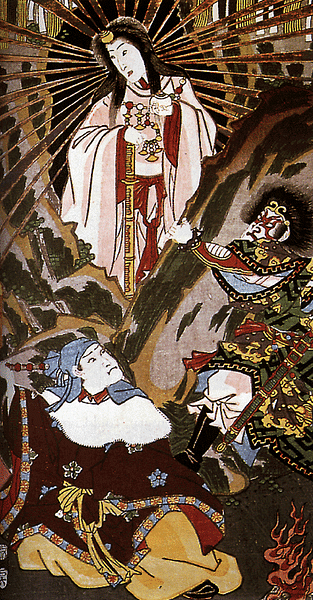
Amaterasu Omikami ('the Great Divinity Illuminating Heaven') is the sun goddess and most important deity of the Shinto religion. Amaterasu is the ruler of Takama no Hara (the High Celestial Plain), the domain of the kami or spirits. The most important Shinto shrine in Japan, the Ise Grand Shrine or Jingu, is dedicated to Amaterasu.
Also known as Oho-hir-me-no-muchi or Amaterasu-oho-hiru-me, Amaterasu is the daughter of Izanami and Izanagi who made their daughter ruler of the sky. When her father Izanagi escaped from his visit to the underworld he had to perform a cleansing ritual in the river Woto and it was then, from the god's left eye, that Amaterasu was born. She is also the elder sister of Susanoo (or Susa-no-wo) the storm god. Amaterasu constantly quarrelled with her mischievous younger brother and finally having enough, she exiled him from heaven.
Amaterasu & the Cave
Perhaps the most celebrated myth concerning Amaterasu is when she blocked herself in a cave following an argument with Susanoo when he surprised the goddess with a monstrous flayed horse when she was quietly weaving in her palace with her younger sister Waka-hiru-me. As a consequence of Amaterasu's disappearance, the world was cast in total darkness and evil spirits ran riot over the earth. The gods tried all manner of ways to persuade the peeved goddess to leave the cave. On the advice of Omohi-Kane, cocks were set outside the cave in the hope their crows would make the goddess think that dawn had come. The gods also placed a large sakaki tree (Cleyera japonica) near the cave entrance and decorated it with sparkling jewels (magatama), fine white clothes and a mirror at its centre. In addition, the goddess Amenouzume (or Ama-no-Uzeme) danced so wildly in a striptease routine that the other gods' uproarious laughter finally excited the curiosity of Amaterasu. Opening the blocked cave just enough to see what was going on and whilst distracted by seeing her stunning reflection in the mirror, the strong god Ame-no-tajikara-wo yanked the goddess out of the cave entrance. Tuto-Tamu then held behind the goddess a pole of plaited straw and emphatically stated that the goddess could hide no longer and the world was once more bathed in her radiant sunlight.
Amaterasu's son is Ama-no-Oshiho-mimi who was requested by his mother to reign over the terrestrial kingdom. However, when he stood on Ama-no-hashidate, the bridge which linked heaven to earth, and saw the disorder amongst the earthly deities he rather petulantly refused the role. At this Amaterasu asked the advice of Taka-mi-Musubi, and consequently, a council of all the gods was convened. The decision of this council was to send Ama-no-Hoki down to earth and properly assess the situation. However, after a period of three years, there had still not been any word from Ama-no-Hoki and so a second council was called. This time the gods sent Ame-waka-hiko armed with his divine bow and arrows. He too, though, proved a less than reliable envoy when he was distracted by and married Shita-teru-hime (the daughter of Oho-kuni-nushi) so that he forgot completely his original mission. After eight years without any news, the gods finally sent the pheasant Na-naki-me to find Ame-waka-hiko. The latter though, on seeing the pheasant, took the bird for a bad omen and swiftly shot the poor creature on the spot with one of his arrows. However, as the arrow was a divine one, it shot straight through the unlucky pheasant and carried on straight up to heaven, landing finally at the feet of Taka-mi-Musubi. The god, rather unimpressed no doubt, promptly threw the arrow back down to earth where it landed rather unfortunately in the chest of Ame-waka-hiko and killed him outright.
Ruling the Underworld
These events necessitated a third council of the gods to be called and it was decided to send Take-mika-zuchi, the god of thunder, and Futsu-nushi, the god of fire, armed with their swords to negotiate with Oho-kuni-nushi, the earthly ruler, and persuade him of the wisdom of recognising Amaterasu's claim to sovereignty over the earth as well as heaven. Oho-kuni-nushi, understandably reluctant to hand over his power without a fuss, consulted his two sons. The eldest son Koto-shiro-nushi counselled his father to concede peacefully, but his younger son Take-minakata advised resistance. The latter then unwisely fought with Take-mika-zuchi but he was no match for the thunder god and was easily defeated. Seeing the hopelessness of his position, Oho-kuni-nushi graciously gave up sovereignty to Amaterasu and left to rule the underworld instead.
The Imperial Regalia of Japan
Now that things were finally sorted out down below, Amaterasu once again asked her son Ama-no-Oshiho-mimi, to govern the earth. For a second time he refused but nominated in his place his son Ninigi-no-Mikoto. To this Amaterasu agreed and gave Ninigi three gifts to help him on his way. These were the Yasakani, a jewel (or pearls), source of the ancient quarrel between Amaterasu and Susanoo; Yata, the mirror from the cave episode; and Kusanagi, the sword Susanoo had plucked from a monster's tail. These would become the three emblems of Ninigi's power (sanshu no jingi) and became the imperial regalia of his descendants, the emperors of Japan. Indeed, the first Japanese emperor, Jimmu (r. 660-585 BCE), who founded the state in 660 BCE was said to be a direct descendant of Amaterasu. This belief allowed successive emperors to likewise claim divine ancestry and so exercise absolute authority.
Amaterasu & the Nobility
Japanese nobility also claimed descent from the goddess when prior to the cave episode she took Susanoo's sword, broke it into three pieces, ate them, and then spat them out as three female deities. Likewise, Susanoo took from his sister her necklace of 500 jewels, ate them, and spat them out as a mist from which formed five male deities. Collectively, these eight deities were believed to be the ancestors of the Japanese nobles.
How is Amaterasu Represented in Art?
In Japanese art, the goddess is most often depicted as a good-natured being often seated back to back with her other brother, Tsukiyomi-no-Mikoto, the moon god. Cocks are associated with her as they herald the rising sun and so, too, the raven (yata garasu) who is believed to be the messenger of the goddess. The Ise Shrine or Jingu, the most important Shinto shrine in Japan, is dedicated to Amaterasu Omikami and the goddess is represented there by one of her other symbols - an octagonal mirror (yata kayami).
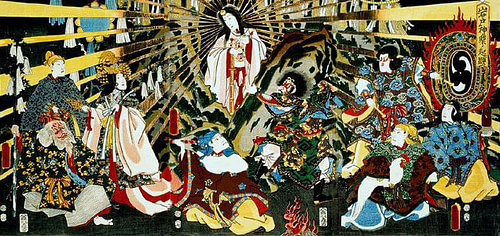
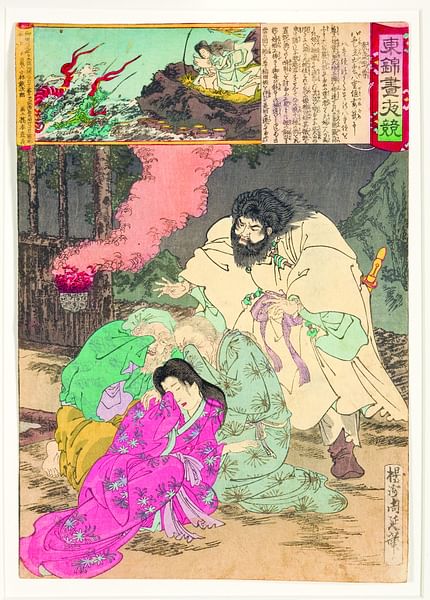
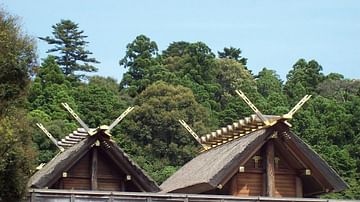
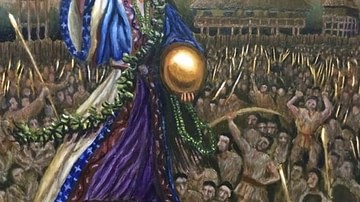

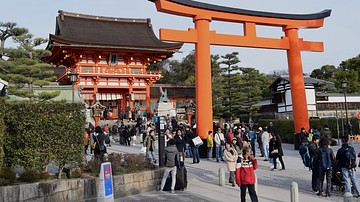

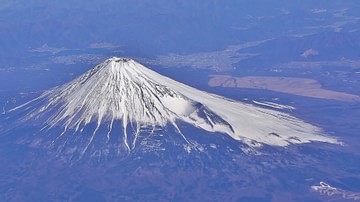

![Amaterasu: Return of the Sun [A Japanese Myth] (Graphic Myths and Legends)](https://m.media-amazon.com/images/I/51cVNvUM2mL._SL160_.jpg)


